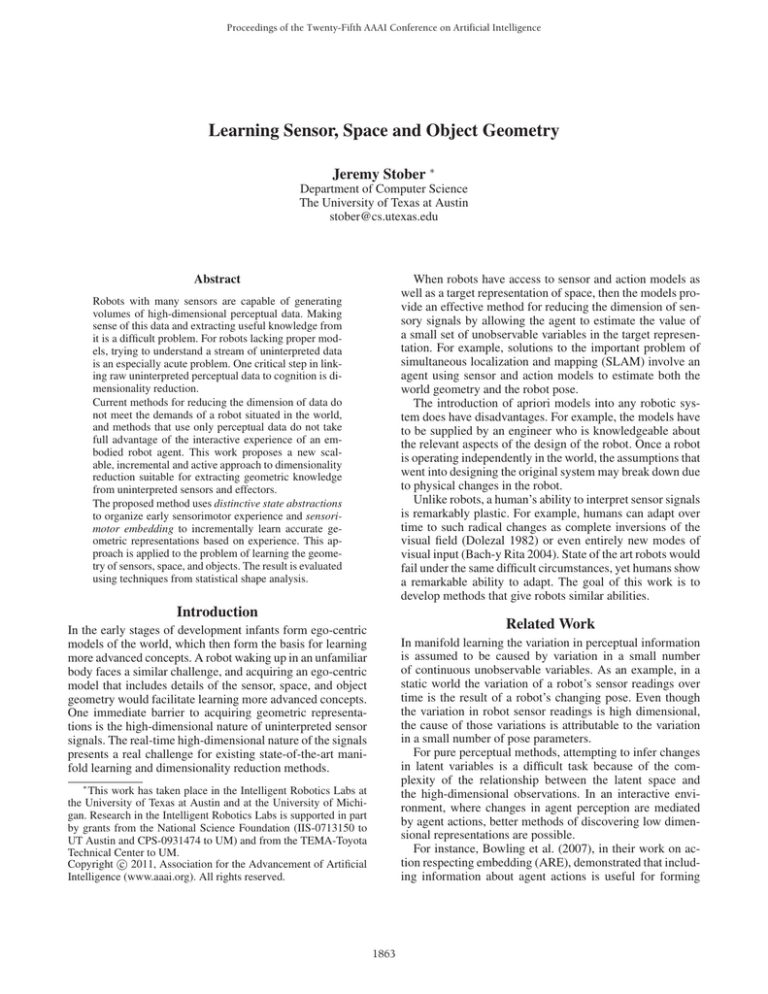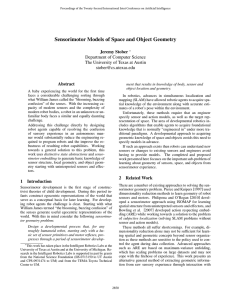
Proceedings of the Twenty-Fifth AAAI Conference on Artificial Intelligence
Learning Sensor, Space and Object Geometry
Jeremy Stober ∗
Department of Computer Science
The University of Texas at Austin
stober@cs.utexas.edu
When robots have access to sensor and action models as
well as a target representation of space, then the models provide an effective method for reducing the dimension of sensory signals by allowing the agent to estimate the value of
a small set of unobservable variables in the target representation. For example, solutions to the important problem of
simultaneous localization and mapping (SLAM) involve an
agent using sensor and action models to estimate both the
world geometry and the robot pose.
The introduction of apriori models into any robotic system does have disadvantages. For example, the models have
to be supplied by an engineer who is knowledgeable about
the relevant aspects of the design of the robot. Once a robot
is operating independently in the world, the assumptions that
went into designing the original system may break down due
to physical changes in the robot.
Unlike robots, a human’s ability to interpret sensor signals
is remarkably plastic. For example, humans can adapt over
time to such radical changes as complete inversions of the
visual field (Dolezal 1982) or even entirely new modes of
visual input (Bach-y Rita 2004). State of the art robots would
fail under the same difficult circumstances, yet humans show
a remarkable ability to adapt. The goal of this work is to
develop methods that give robots similar abilities.
Abstract
Robots with many sensors are capable of generating
volumes of high-dimensional perceptual data. Making
sense of this data and extracting useful knowledge from
it is a difficult problem. For robots lacking proper models, trying to understand a stream of uninterpreted data
is an especially acute problem. One critical step in linking raw uninterpreted perceptual data to cognition is dimensionality reduction.
Current methods for reducing the dimension of data do
not meet the demands of a robot situated in the world,
and methods that use only perceptual data do not take
full advantage of the interactive experience of an embodied robot agent. This work proposes a new scalable, incremental and active approach to dimensionality
reduction suitable for extracting geometric knowledge
from uninterpreted sensors and effectors.
The proposed method uses distinctive state abstractions
to organize early sensorimotor experience and sensorimotor embedding to incrementally learn accurate geometric representations based on experience. This approach is applied to the problem of learning the geometry of sensors, space, and objects. The result is evaluated
using techniques from statistical shape analysis.
Introduction
Related Work
In the early stages of development infants form ego-centric
models of the world, which then form the basis for learning
more advanced concepts. A robot waking up in an unfamiliar
body faces a similar challenge, and acquiring an ego-centric
model that includes details of the sensor, space, and object
geometry would facilitate learning more advanced concepts.
One immediate barrier to acquiring geometric representations is the high-dimensional nature of uninterpreted sensor
signals. The real-time high-dimensional nature of the signals
presents a real challenge for existing state-of-the-art manifold learning and dimensionality reduction methods.
In manifold learning the variation in perceptual information
is assumed to be caused by variation in a small number
of continuous unobservable variables. As an example, in a
static world the variation of a robot’s sensor readings over
time is the result of a robot’s changing pose. Even though
the variation in robot sensor readings is high dimensional,
the cause of those variations is attributable to the variation
in a small number of pose parameters.
For pure perceptual methods, attempting to infer changes
in latent variables is a difficult task because of the complexity of the relationship between the latent space and
the high-dimensional observations. In an interactive environment, where changes in agent perception are mediated
by agent actions, better methods of discovering low dimensional representations are possible.
For instance, Bowling et al. (2007), in their work on action respecting embedding (ARE), demonstrated that including information about agent actions is useful for forming
∗
This work has taken place in the Intelligent Robotics Labs at
the University of Texas at Austin and at the University of Michigan. Research in the Intelligent Robotics Labs is supported in part
by grants from the National Science Foundation (IIS-0713150 to
UT Austin and CPS-0931474 to UM) and from the TEMA-Toyota
Technical Center to UM.
c 2011, Association for the Advancement of Artificial
Copyright Intelligence (www.aaai.org). All rights reserved.
1863
0.0
0.2
0.4
0.6
0.8
1.0
accurate low-dimensional embeddings of sensor information. In other work, Philipona et al. (2010) have shown how
ISOMAP can be extended using information derived from
local agent actions.
The approach presented here builds on prior work and
seeks to solve several outstanding issues. For example,
bounds on computational resources makes applying manifold learning difficult in situations involving lifetime learning of embodied agents. In addition, methods that use only
local information like ISOMAP can fail to recognize important aspects of the global state space geometry. Finally,
many traditional methods for dimensionality reduction fail
to identify the appropriate scale for data, opting instead
for some normalized scale for the resulting representation.
The method presented here offers a compelling alternative,
where scale is determined based on agent actions and calibrated to an agent’s own body.
1
(a)
2
3
4
5
(b)
6
(c)
Figure 1: (a) shows an optimal policy in a grid-world with
one distinctive goal state. (b) shows the decrease in geometry error as the policy improves. (c) shows the final representation of the relative positions of the states using sensorimotor embedding and an optimal policy.
ARE in the I MAGE B OT domain. In addition, recent work
on learning object geometry in computer vision has relied
on relating distinctive views of objects using homographies
(Savarese and Fei Fei 2007). The proposed method will
build object models using distinctive states and learned policies for navigating to and between these distinctive states.
The primary method of evaluation will involve comparing
computed geometry with ground truth geometry using sample points drawn from both representations. These point sets
can be compared using statistical shape analysis. Secondary
analysis such as scree diagrams and subjective comparisons
of the resulting representations will also be performed.
Modeling Geometry
In the completed and proposed work, an agent takes a multistep approach to acquiring geometric knowledge. First, an
agent forms a distinctive state abstraction (DSA) using a
simple set of hill-climbing control laws. The fixed points of
these control laws are the distinctive states. The DSA allows the agent to scale the learning process to large domains
by separating large domains into local learning problems
around each distinctive state. The DSA provides a concrete
set of policy improvement goals for efficiently moving to
and between distinctive states.
As the agent learns progressively better policies, the agent
applies sensorimotor embedding to extract geometric knowledge implicit in the learned policies. Sensorimotor embedding first computes similarities between all states in the region of a single distinctive state. The similarity between any
two states, s and s , is computed by comparing the sequences
and < aj >m−1
, generated by the
of actions, < ai >n−1
1
1
policy πi , that bring an agent to a shared distinctive state.
Formally,
Conclusion
The proposed and completed work provides a incremental,
scalable and active method for learning geometry from sensorimotor experience. Both DSAs and sensorimotor embedding provide developing agents with new tools to understand
and adapt to uninterpreted sensors and effectors in complex
environments.
References
Bach-y Rita, P. 2004. Tactile sensory substitution studies.
Annals of the New York Academy of Sciences 1013:83.
Bowling, M.; Wilkinson, D.; Ghodsi, A.; and Milstein, A.
2007. Subjective localization with action respecting embedding. Robotics Research 28:190–202.
Dolezal, H. 1982. Living in a World Transformed: Perceptual and Perfomatory Adaptation to Visual Distortion. Academic Press.
Philipona, D., and O’Regan, J. 2010. The sensorimotor approach in CoSy: The example of dimensionality reduction.
Cognitive Systems 95–130.
Savarese, S., and Fei Fei, L. 2007. 3D generic object categorization, localization and pose estimation. In IEEE 11th
International Conference on Computer Vision, 1–8.
Stober, J.; Fishgold, L.; and Kuipers, B. 2009. Learning
the sensorimotor structure of the foveated retina. In Proceedings of the Ninth International Conference on Epigenetic Robotics.
δπi (s, s ) ≡ DTW(< ai >n−1
, < aj >m−1
),
1
1
where DTW stands for dynamic time warping.
Within each region of a distinctive state, the geometric
representation of the local state space is generated using
multidimensional scaling applied to the matrix of dynamic
time warping comparisons (Figure 1).
Completed and Proposed Work
Stober et al. (2009) have shown how sensorimotor embedding can be applied to learning the structure of a foveated
(non-uniform) sensor. In that work the sensor geometry was
derived from a learned saccade policy. This method was
shown to have several important advantages, as the learned
sensor geometry could adapt dynamically to considerable
changes in actual sensor geometry, including total visual inversion and simulated macular degeneration.
Proposed work will focus on learning the structure of
space and objects using the same process. For learning spatial geometry, this method will be compared directly with
1864


